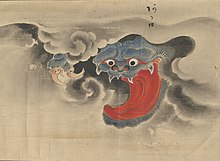Akashita: Difference between revisions
PkbwcgsBot (talk | contribs) m Task 4 trial - fixing WP:WCW error 3 (Reference list missing) with WP:GenFixes turned on |
No edit summary |
||
| Line 5: | Line 5: | ||
{{nihongo|'''Akashita'''|赤舌||lit. "red tongue"}} is a ''[[yōkai]]'' that appeared in [[Toriyama Sekien]]'s ''[[Gazu Hyakki Yakō]]''. It is drawn as a beast with clawed hands and a hairy face, with most of its body hidden in a black cloud over a floodgate. It is characterized by its open mouth and large tongue. Sekien did not attach an explanatory note about this ''[[yōkai]]'', but its origins are identifiable as Akaguchi which appears in older [[Edo period]] ''[[yōkai]]'' scrolls such as [[Bakemono no e]]. This ''[[yōkai]]'' is known interchangeably as Akaguchi and Akashita.<ref name=":0">{{Cite book|title=Ketteiban Nihon yōkai taizen: Yōkai anoyo kamisama|last=Mizuki|first=Shigeru|publisher=Kodansha|year=2014|isbn=9784062776028|location=Tokyo|pages=32}}</ref> |
{{nihongo|'''Akashita'''|赤舌||lit. "red tongue"}} is a ''[[yōkai]]'' that appeared in [[Toriyama Sekien]]'s ''[[Gazu Hyakki Yakō]]''. It is drawn as a beast with clawed hands and a hairy face, with most of its body hidden in a black cloud over a floodgate. It is characterized by its open mouth and large tongue. Sekien did not attach an explanatory note about this ''[[yōkai]]'', but its origins are identifiable as Akaguchi which appears in older [[Edo period]] ''[[yōkai]]'' scrolls such as [[Bakemono no e]]. This ''[[yōkai]]'' is known interchangeably as Akaguchi and Akashita.<ref name=":0">{{Cite book|title=Ketteiban Nihon yōkai taizen: Yōkai anoyo kamisama|last=Mizuki|first=Shigeru|publisher=Kodansha|year=2014|isbn=9784062776028|location=Tokyo|pages=32}}</ref> |
||
Akaguchi has association with the use of water in farming country.<ref name=":0" /> Though some sources say Akaguchi is simply an omen of bad luck, others represent Akaguchi as a protective spirit.<ref name=":1">{{Cite book|title=Japandemonium Illustrated: The Yōkai Encyclopedias of Toriyama Sekien|last=Yoda|first=Hiroko|publisher=Dover Publications, Inc.|year=2016|isbn=9780486800356|location=New York|pages=68}}</ref><ref name=":0" /> During droughts, water is carefully controlled and distributed equally to farmers in the area. As a form of warfare, some would siphon above the allotted amount of water for their personal fields. This was a great crime and could cost neighboring farmers their livelihood. It was believed that the perpetrators of this crime not punished by law would be punished by Akaguchi. If these criminals came near the floodgate Akaguchi would appear and swallow them scooping them up with its giant red tongue.<ref>{{Cite book|title=Nihon no yōkai hyakka: Bijuaruban|last=Iwai|first=Hiromi|publisher=Kawade Shobō Shinsha|year=2015|isbn=9784309226293|location=Tokyo|pages=153–155}}</ref> |
Akaguchi has association with the use of water in farming country.<ref name=":0" /> Though some sources say Akaguchi is simply an omen of bad luck, others represent Akaguchi as a protective spirit.<ref name=":1">{{Cite book|title=Japandemonium Illustrated: The Yōkai Encyclopedias of Toriyama Sekien|last=Yoda|first=Hiroko|publisher=Dover Publications, Inc.|year=2016|isbn=9780486800356|location=New York|pages=68}}</ref><ref name=":0" /> During droughts, water is carefully controlled and distributed equally to farmers in the area. As a form of warfare, some would siphon above the allotted amount of water for their personal fields. This was a great crime and could cost neighboring farmers their livelihood. It was believed that the perpetrators of this crime not punished by law would be punished by Akaguchi. If these criminals came near the floodgate Akaguchi would appear and swallow them, scooping them up with its giant red tongue.<ref>{{Cite book|title=Nihon no yōkai hyakka: Bijuaruban|last=Iwai|first=Hiromi|publisher=Kawade Shobō Shinsha|year=2015|isbn=9784309226293|location=Tokyo|pages=153–155}}</ref> |
||
The name Akashita may be correlated to {{nihongo|''shakuzetsujin''|赤舌神||lit. "red-tongued god"}} which guards the western gate of Jupiter. It may also be related to the {{nihongo|''shakuzetsunichi''|赤舌日}}, a day of bad luck in ''[[Onmyōdō]]''. |
The name Akashita may be correlated to {{nihongo|''shakuzetsujin''|赤舌神||lit. "red-tongued god"}} which guards the western gate of Jupiter. It may also be related to the {{nihongo|''shakuzetsunichi''|赤舌日}}, a day of bad luck in ''[[Onmyōdō]]''. |
||
Revision as of 20:21, 20 January 2019
This article includes a list of general references, but it lacks sufficient corresponding inline citations. (July 2017) |


Akashita (赤舌, lit. "red tongue") is a yōkai that appeared in Toriyama Sekien's Gazu Hyakki Yakō. It is drawn as a beast with clawed hands and a hairy face, with most of its body hidden in a black cloud over a floodgate. It is characterized by its open mouth and large tongue. Sekien did not attach an explanatory note about this yōkai, but its origins are identifiable as Akaguchi which appears in older Edo period yōkai scrolls such as Bakemono no e. This yōkai is known interchangeably as Akaguchi and Akashita.[1]
Akaguchi has association with the use of water in farming country.[1] Though some sources say Akaguchi is simply an omen of bad luck, others represent Akaguchi as a protective spirit.[2][1] During droughts, water is carefully controlled and distributed equally to farmers in the area. As a form of warfare, some would siphon above the allotted amount of water for their personal fields. This was a great crime and could cost neighboring farmers their livelihood. It was believed that the perpetrators of this crime not punished by law would be punished by Akaguchi. If these criminals came near the floodgate Akaguchi would appear and swallow them, scooping them up with its giant red tongue.[3]
The name Akashita may be correlated to shakuzetsujin (赤舌神, lit. "red-tongued god") which guards the western gate of Jupiter. It may also be related to the shakuzetsunichi (赤舌日), a day of bad luck in Onmyōdō.
References
- ^ a b c Mizuki, Shigeru (2014). Ketteiban Nihon yōkai taizen: Yōkai anoyo kamisama. Tokyo: Kodansha. p. 32. ISBN 9784062776028.
- ^ Yoda, Hiroko (2016). Japandemonium Illustrated: The Yōkai Encyclopedias of Toriyama Sekien. New York: Dover Publications, Inc. p. 68. ISBN 9780486800356.
- ^ Iwai, Hiromi (2015). Nihon no yōkai hyakka: Bijuaruban. Tokyo: Kawade Shobō Shinsha. pp. 153–155. ISBN 9784309226293.
- "Aka-shita". The Obakemono Project. Archived from the original on 10 April 2008. Retrieved 2008-04-18.
{{cite web}}: Unknown parameter|deadurl=ignored (|url-status=suggested) (help) - 赤舌 (in Japanese). Archived from the original on 11 April 2008. Retrieved 2008-04-18.
{{cite web}}: Unknown parameter|deadurl=ignored (|url-status=suggested) (help)
